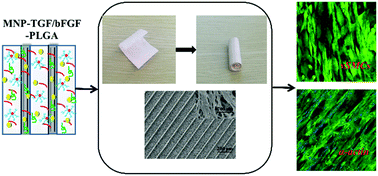Fabrication and effect on regulating vSMC phenotype of a biomimetic tunica media scaffold
Abstract
An ideal vascular tissue engineering scaffold should imitate physical and biochemical cues in native vessels for guiding cell growth, differentiation and tissue formation. The tunica media provides a key structure and function support for native vessels. In this study, a film-like MNP-TGF/bFGF-PLGA scaffold that simulated physical and biochemical cues of tunica media in native vessels was fabricated by soft lithography combined with solution casting and phase separation technique. The scaffold had dual surface topographies of parallel arranged microgrooves and nanofiber structures, and interconnected pores to be able to deliver nutrient and eliminate metabolized products. The TGF-β1 and bFGF immobilized on the scaffold by silica nanoparticle binding and plasma treatment technique could maintain continuous release for 10 and 7 days, respectively. The synergy effect of the dual surface topography and released growth factors endowed the MNP-TGF/bFGF-PLGA scaffold with good capacity on regulating vascular smooth muscle cell (vSMC) phenotype. Importantly, the scaffold possessed good mechanical properties and could easily be rolled into a multilayer cylindrical tube as a promising biomimic vascular tissue engineering scaffold.


 Please wait while we load your content...
Please wait while we load your content...